After 76 years, Tuskegee Airmen Congressional Medals to be Presented to the Family of Robert & Estelle Terry
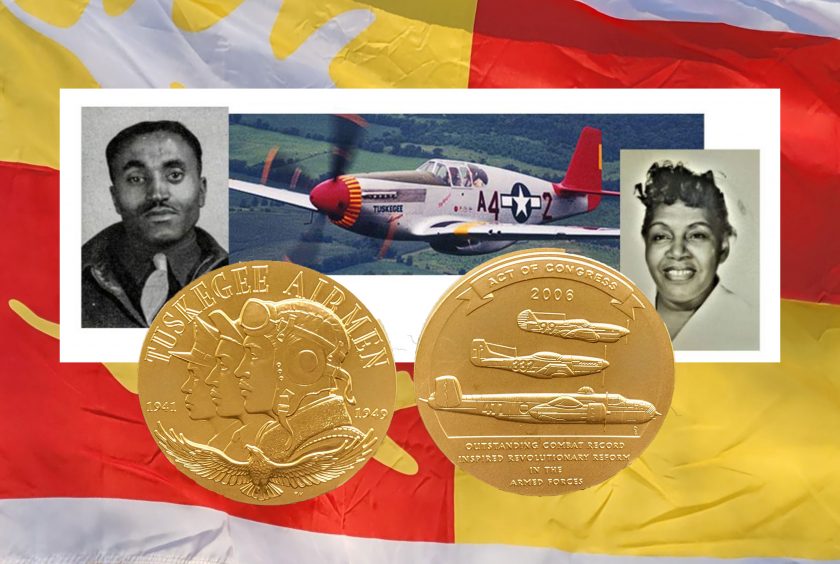
It took almost two years for Brooks Betz, historian and researcher, to prepare a story about Captain Robert and Estelle Terry, who resided in Basking Ridge, New Jersey. Based on the research, the non-profit Mr. Local History project felt it would be fantastic if the final chapter of the story was the surviving family being awarded the Tuskegee Congressional Medal of Honor. That’s about to happen. This ceremony writes that final chapter, as the Mr. Local History Project and New Jersey dignitaries will present the Terry family with two Congressional medals awarded to Tuskegee Airmen.
Captain Robert Terry and his wife, Estelle Terry, will be honored on July 21, 2022, as letters of recognition will be presented by Delegates from the offices of Senators Corey Booker, Robert Menendez, and Representative Tom Malinowski. Then, Brooks Betz and Meg Wastie, Trustees on the Mr. Local History Project, will present authentic Tuskegee Congressional medals to the Terry family in the Basking Ridge section of Bernards Township, New Jersey. Mr. Local paid for the medals through private donations. If you’d like to support, click here and make a tax-deductible donation (always appreciated).

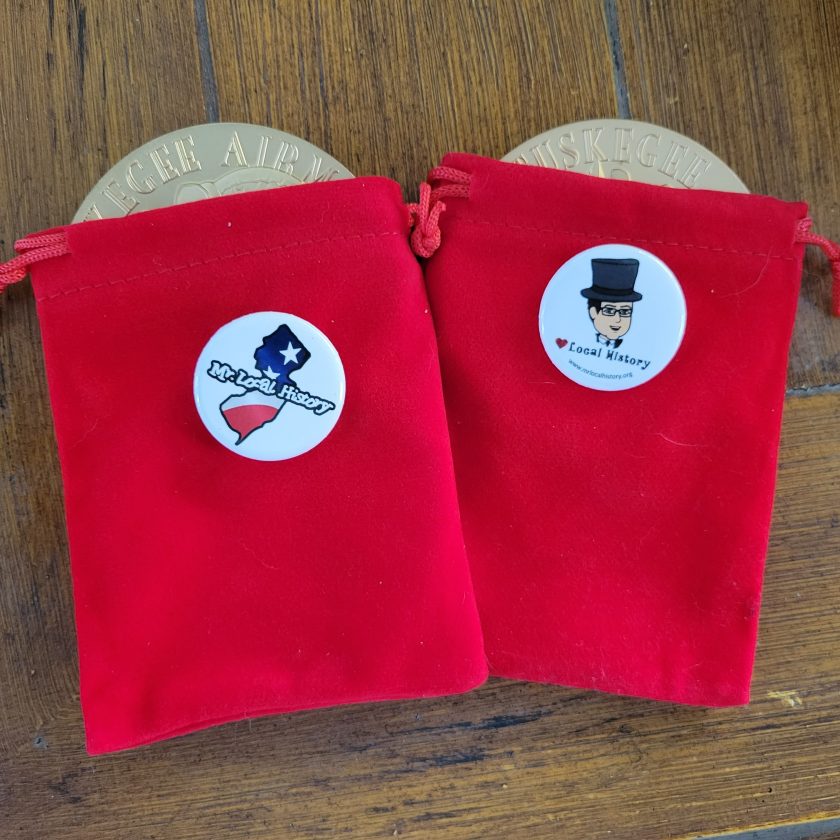
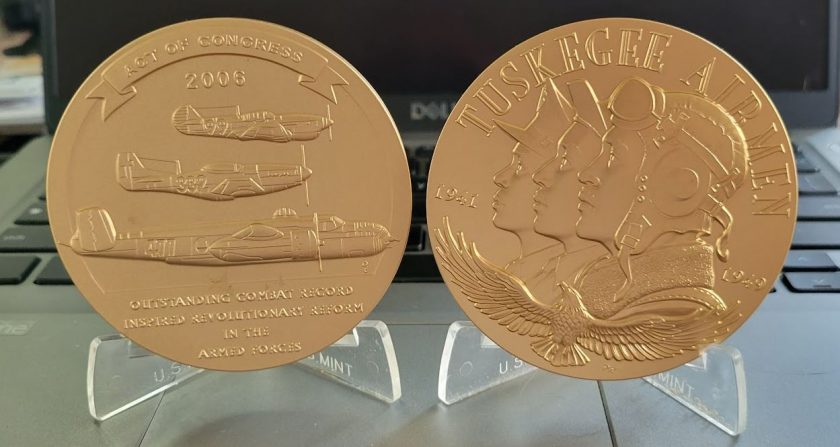
Civilian Pilot and Army Air Force Instructor Robert (Bob) Terry from Basking Ridge, New Jersey, was a groundbreaking Pilot in WWII….and yes, he was black.
You would think being black today and being a pilot didn’t matter, and it doesn’t. In fact, it never did. But you put yourself in the shoes of Robert Terry and the Tuskegee Airmen, and you learn there was a huge difference. The Mr. Local History Project takes a look back at this inspiring Basking Ridge resident and his story.
In June 1939, the Civilian Pilot Training Act was signed into law, authorizing civilian schools to train military pilots. A last-minute amendment allowed the limited inclusion of African Americans in the program. The Tuskegee Institute in Tuskegee, Alabama, was among the black colleges approved to provide the training.
From 1941 through 1945, all black military pilots trained at Griel Field, Kennedy Field, Moton Field, Shorter Field, and the Tuskegee Army Air Fields. They were educated at the Tuskegee Institute located in Tuskegee, Alabama. They had their own medical units, surgeons, and places to eat. You see, white surgeons weren’t allowed to operate on black soldiers.
This group of pilots from the 99th Flying Training Squadron and the 99th Pursuit Fighter Squadron made a name for themselves as being experts in the sky, while also breaking racial barriers at home. The Tuskegee Airmen were the first black military aviators in the United States Army Air Forces (USAAF), the precursor to the United States Air Force (USAF).
Meet Basking Ridge’s Captain Robert Terry
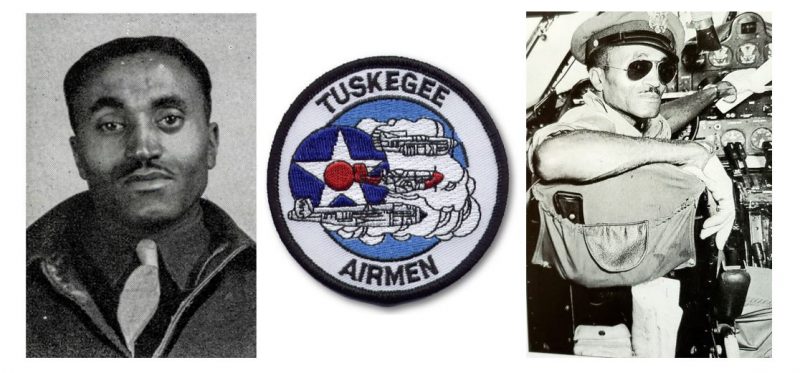
Photo: Air Force Historical Research Agency and Arcadia Books
Captain Robert Terry was a flight instructor and pilot from Basking Ridge for the Tuskegee Airmen from 1943 to 1945. After a brief period at North Carolina A&T College in Greensboro, North Carolina, Terry used the black college’s Civilian Pilot Program to secure a position with the Tuskegee Airmen in Tuskegee, Alabama.
Terry taught young black men to fly fighter Curtis P-40 Warhawks, Bell P-39 Airacobras, and P-51 Mustang fighter planes that served America well during the European campaign in North Africa and Italy. Terry also trained other pilots to escort B-17 and B-24 heavy bombers, using P-47 and P-51 airplanes at the USAAF Motor field in Tuskegee, Alabama.

Formed as the 332nd Fighter Group and the 477th Bombardment Group of the United States Army Air Forces, the 332nd Fighter Group was the first black flying group in the USAF. After training, they were first deployed to North Africa in April 1943, and later to Sicily and Italy.
Early Years
Robert Terry was born July 23, 1911, on a farm where his parents were employed in Mendham, New Jersey. Later, Beverly (Robert’s father) purchased a modest farm on what was then called “Building Lane,” in honor of the late William Alexander’s (Lord Stirling) nearby 1700s estate. The road is now called Lord Stirling Road in the Basking Ridge section of Bernards Township, New Jersey.
Terry was a 1930 graduate of Bernards High School in Bernardsville, as Basking Ridge didn’t have a high school at the time. Later, Robert lived in the home with his wife Estelle Brock Terry, son Robert Jr., son Beverly Jr. and Robert Terry’s father Beverly. Robert’s grandchildren from Robert Jr. were also raised in the same house.
In 1931, luck should have it that a new airport was being constructed across the street from Terry’s house on Lord Stirling Road in Basking Ridge to support the opening of the nearby Lyons Veterans Administration hospital, which was approved by President Coolidge the year before, in 1930. So perhaps Terry could get a job and change his fortunes.
In early 1931, before the opening of the new Somerset Hills Airport, Terry went across the street and asked the Airport managers, George Viehmann and Waldron Schanz, if he could aid the airport construction before it opened. Terry was hired. Terry convinced the owners to give him flying lessons in exchange for work clearing the runway. Once Terry got his chance to fly, he never looked back.
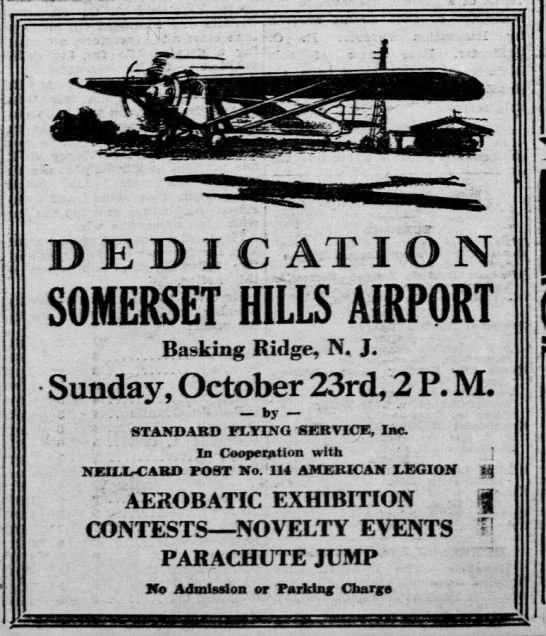
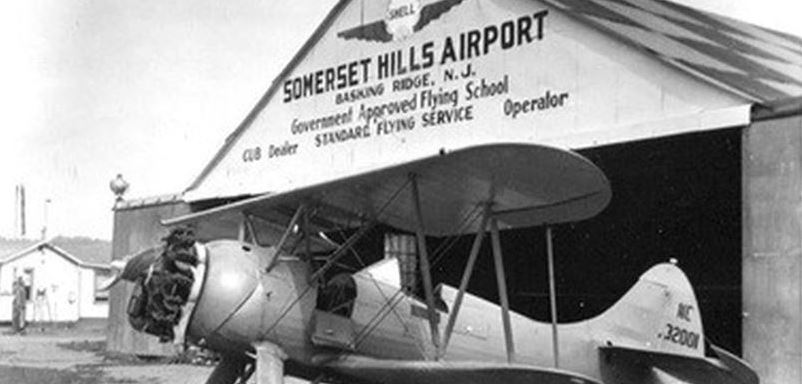
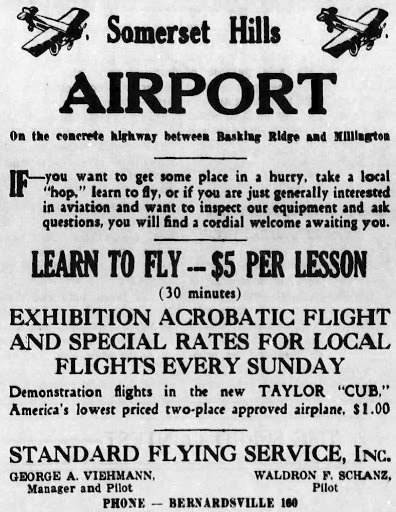
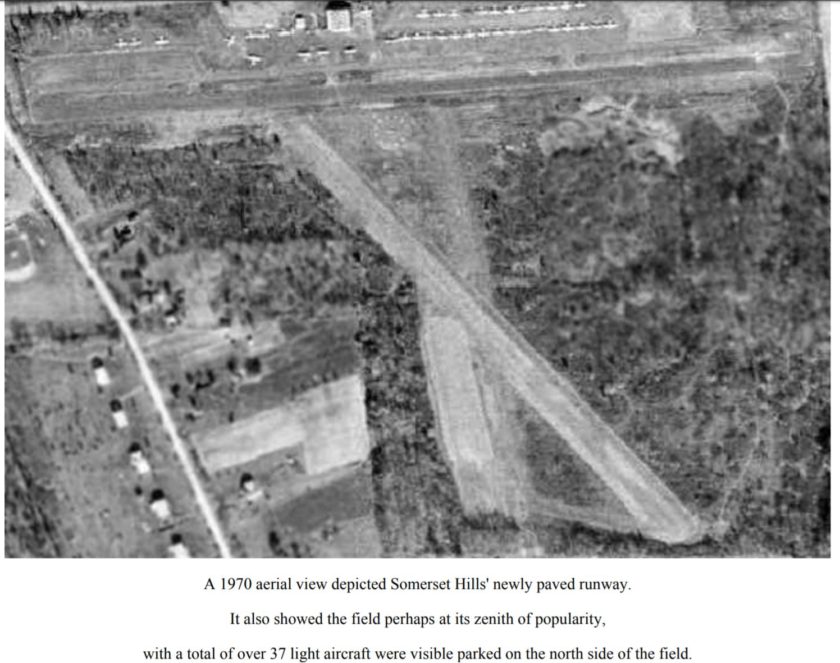
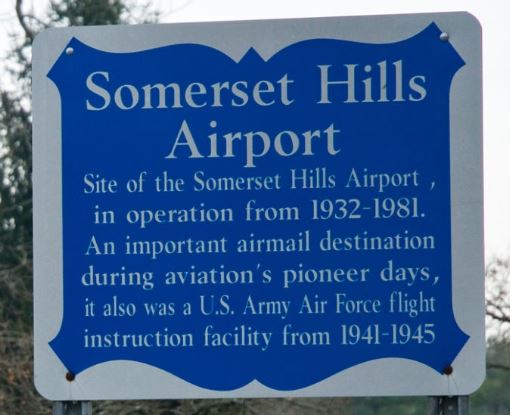
After Terry soloed in April 1932, he became a flight instructor at the airport. Terry received his commercial pilot’s license on December 7, 1939, from the Somerset School of Aeronautics at the Somerset Airfield. He received his official instructor’s license on March 13, 1940. While he couldn’t rent a plane because he was black, facility staff and friends always stepped in and co-signed on his behalf.
The Civilian Pilot Training Act of 1939
In 1939, Congress passed the Civilian Pilot Training Act, which required that African-Americans be included in civilian pilot training, and Public Law 18, which eventually resulted in an African-American military flying unit. In 1940, black pilots began training at Tuskegee Institute as part of the Civilian Pilot Training Program.
Terry was the fifth negro flying instructor in the country and the first student to solo at the Somerset Hills Airfield in Basking Ridge, NJ. Terry became an official flying instructor for the Civilian Training Program at the Agricultural and Technical College in Greensboro, North Carolina, on March 13, 1940, just a year after the program commenced.
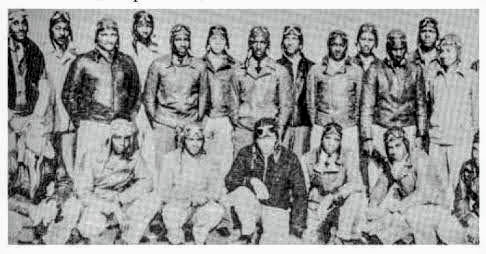
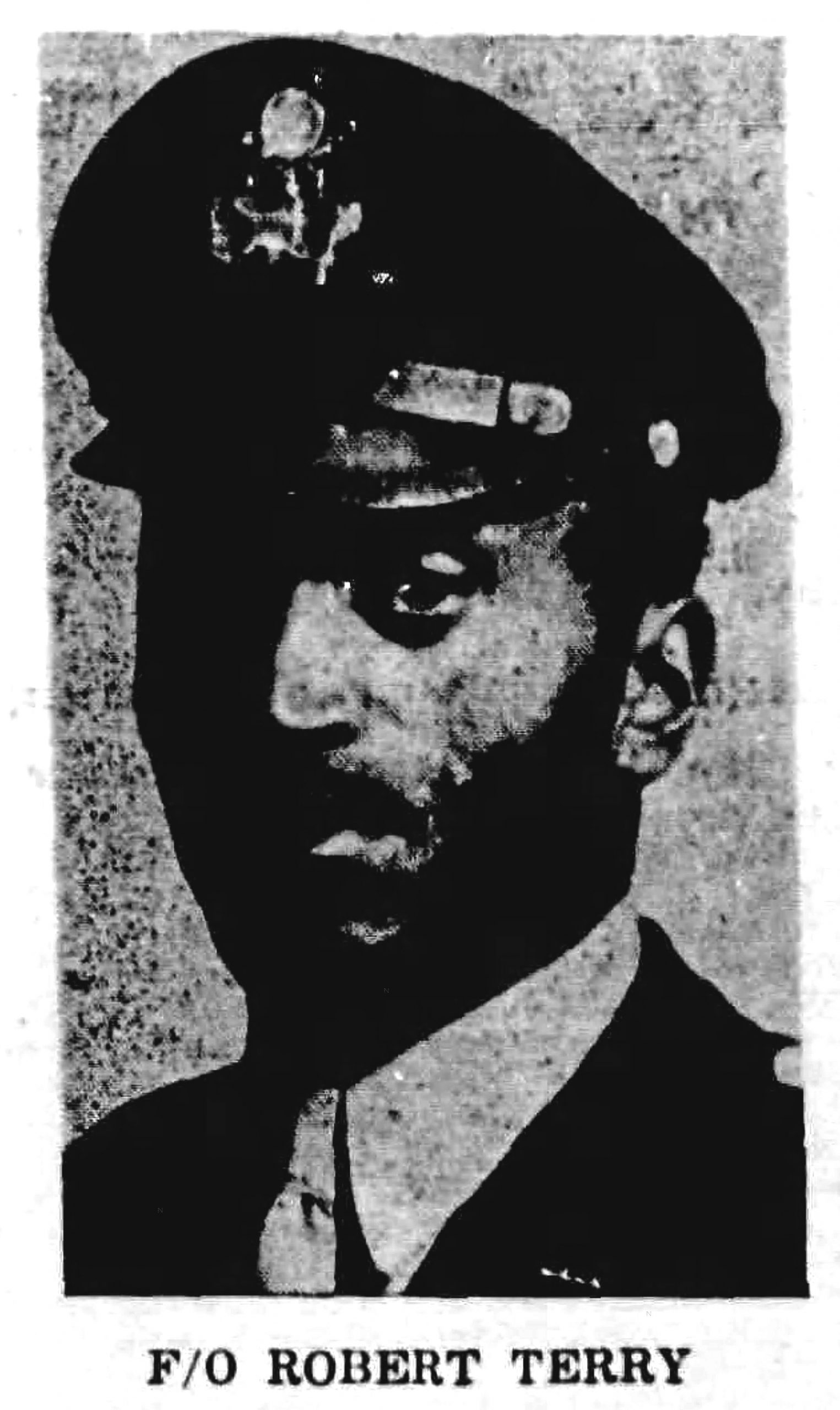
In photo: Civilian Primary Instructors: Bob Terry, John XE “John” Young, Stevens, Charles XE “Charles” Fox, Roscoe XE “Roscoe” Draper, Sherman XE “Sherman” Rose, James XE “James” A. Hill, Adolph Moret, Ernest XE “Ernest” Henderson, Matthew XE “Matthew” Plummer, Linwood XE “Linwood” Williams XE “Williams” , Daniel C. James, Lewis XE “Lewis” Jackson XE “Jackson” , Milton XE “Milton” Crenshaw, Perry XE “Perry” Young, Charlie Flowers, Claude Platt, “Chief XE “Chip” ” Anderson, C.R. Harris, Wendell XE “Wendell” Lipscomb, J. E. XE “J. E.” Wright. December 2, 1942.
Source: Library of Congress.
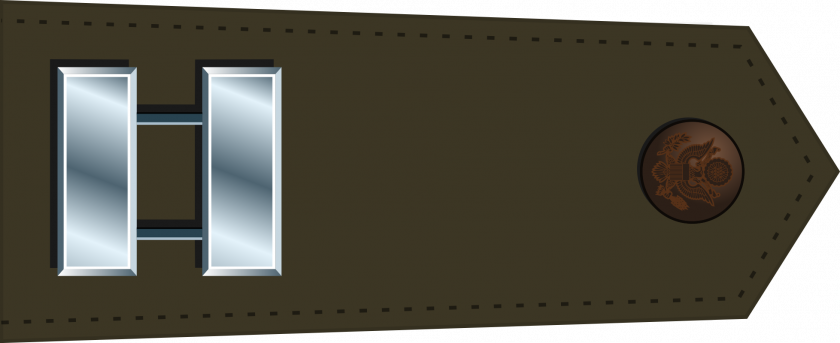
Meet Robert’s Wife Estelle Brock Terry and Son Robert Jr.
Estelle Brock was born and raised in South Orange, New Jersey. She married Robert around 1940 (verification pending), and they lived in Robert’s father’s house in Basking Ridge. What many people didn’t realize was that Estelle was a licensed pilot, mail clerk, and parachute packer at Tuskegee, following her husband’s lead. She was featured in the film” To Serve My Country, To Serve My Race by Lawrence Walker in 1997. She is also interviewed in Lawrence Walker’s second documentary Sweet Georgia Brown. (see trailer below.)
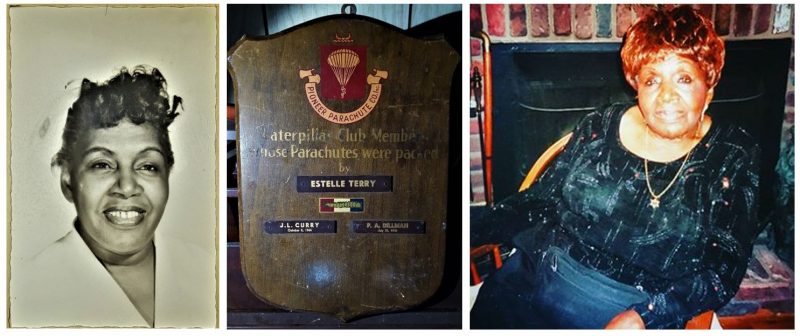
Estelle stayed in Basking Ridge until Robert’s death. Robert Terry Sr. died in 1958 at the age of 48 of pneumonia, when Robert Jr. was only 11. Saalik remembers when he turned 18, he and Estelle then moved back to South Orange, NJ, but kept the Basking Ridge property. Bob Jr. became an accomplished athlete at Columbia Regional High School in nearby Maplewood, New Jersey. He received numerous college scholarships before he graduated in 1963. Terry was an accomplished athlete in football, wrestling, lacrosse, judo, and ice hockey, among others. Football was his favorite sport. He was chosen to the US Judo team for the 1964 Tokyo Summer Games as an alternate. This was the first time the sport was included in the Summer Olympic Games.
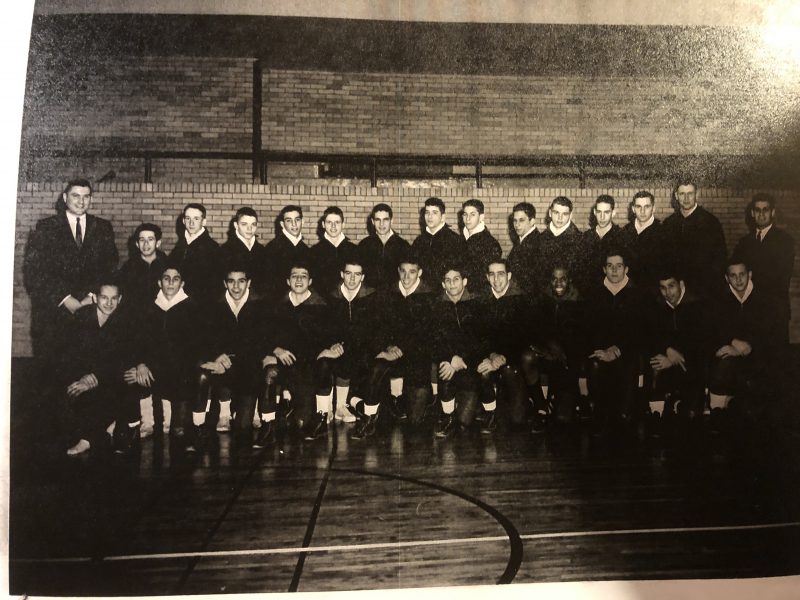
My dad received a scholarship to Trinidad College in Colorado for wrestling. He then went to Duquesne University in Pittsburgh where he studied photography. Terry graduated Duquesne and then moved to Tucson Arizona where he took a job as a bouncer and started teaching photography at Pima College.
He also starting taking pottery classes at that time because he wanted to join an Arizona Arts collective but he couldn’t join with photography as they only accepted arts and crafts. He took up pottery which would later be his livelihood. He had to come back to New Jersey to help his mother out with his grandmother “Big mommy” as she had taken ill, suffering from dementia. He then moved to New York and became a VISTA volunteer with my mother, Grendl Terry, and worked in Brownsville working with teenagers and provided counseling.
Malika Ra – Robert Terry Jr.’s daughter.
Dr. Qaaim Saalik graduated from the University of Arizona with a degree in fine arts. He was also a professor at Seton Hall University. He also founded the pottery company, Great Swamp Pottery, in the 80s.
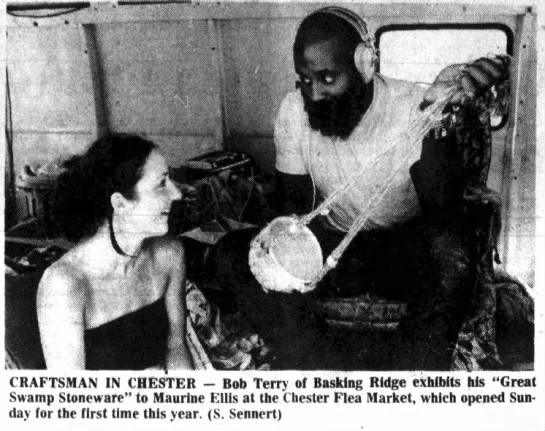
Estelle Brock Terry, 93, died on July 12, 2009, in Salem, Alabama. Raised in South Orange, Estelle was predeceased by her husband, Robert, and sister, Cleo H. Gatewood. She was survived by her son, Qaaim Saalik (Robert Terry Jr.), and her grandchildren, Malika Ra and Ramdasha Bikceem.
My father was in the air more than he was on the ground.
Terry’s son Robert Terry Jr.
(later changed his name to Qaaim Saalik)
Qaaim Saalik (Robert R. Terry) later took on a project and became the executive director of On Cloud Nine: African-American Pilots of World War II, a multimedia project. The documentary film was never completed. But an associate, Lawrence Walker, did document two films, including Saalik’s mother, Estelle. Dr. Saalik is currently living in the Bronx. He has two daughters, Malkia Ra and Ramdasha Bikceem.
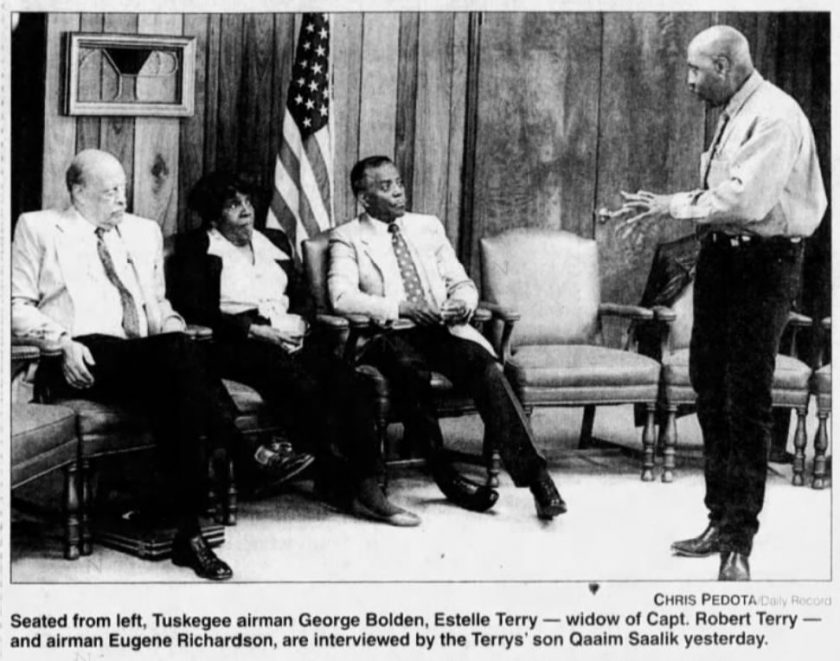
Honoring Robert & Estelle Terry
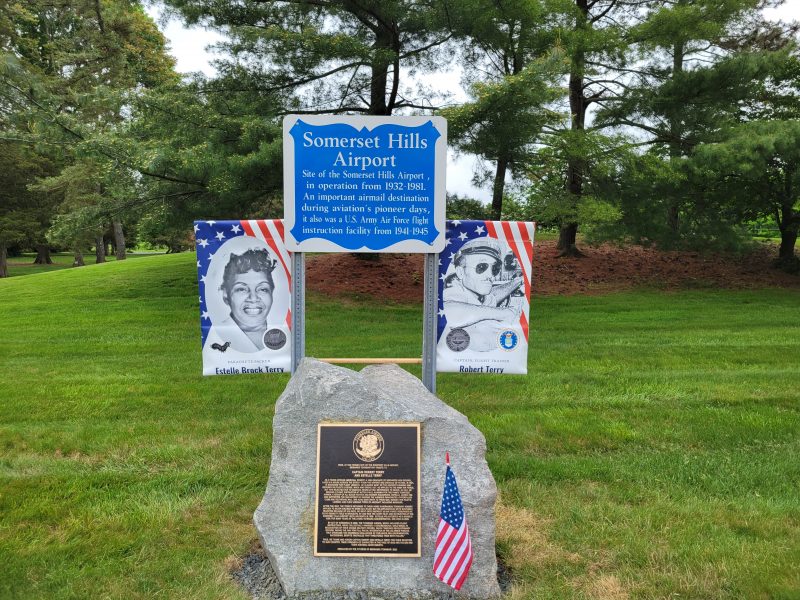
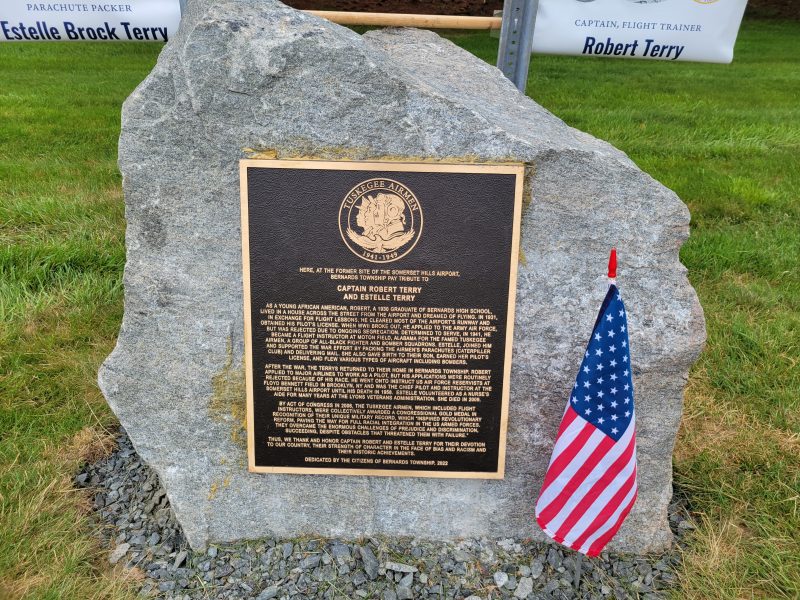
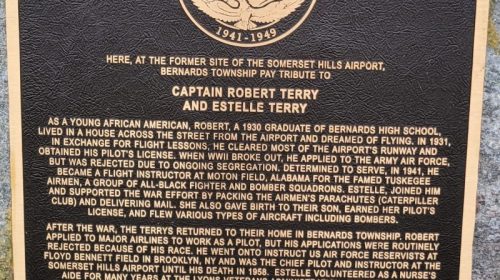
The memorial is just across South Maple Avenue from the War Memorial Field in Basking Ridge, New Jersey.
Local Residents Remember
Many local residents from Basking Ridge wrote us stating that Terry’s skill as a pilot won him an exemption from prejudice in Bernards Township. It was a different story when Terry applied to major airlines for a commercial pilot position. In each instance, he was turned down, and Terry never landed a commercial pilot job at a major airline. But he was respected for his accomplishments, and he spent the remainder of his pilot’s career working at the Somerset Hills airfield, just across the street from his house on Lord Stirling Road, as the Chief Flight Instructor.
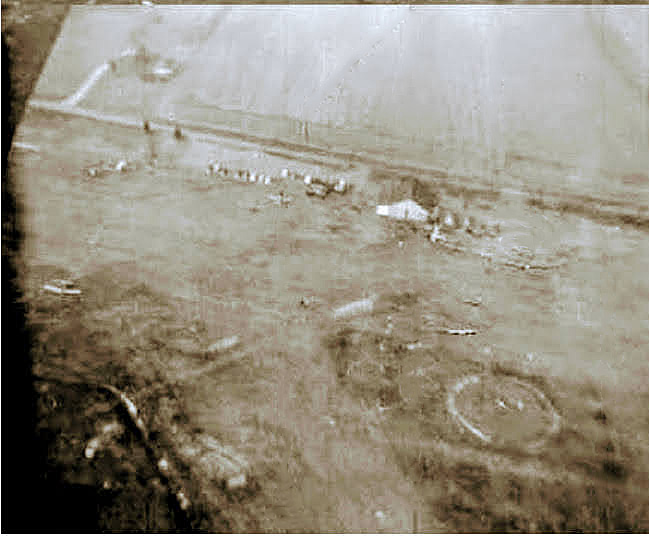
Source: Paul Downing.

There was a house set back from the road directly opposite the airport on Lord Stirling Rd.the airport owner was good friends with Mr Terry and had helped him settle in that home just behind the airport at 16 Lord Stirling Road. His wife as I remember worked as a nurse at the newly built Veterans Hospital in nearby Lyons.
Deborah L.ewis – Basking Ridge
Bob Terry lived across from the airport on Lord Stirling Road behind the airport. He was a friend of my dad. Dad said he could fly anything. I believe he was a training officer for the airmen. I think he retired after flying for Strategic Air Command flying bombers as a Lieutenant Colonel.
Jim McArthur, Basking Ridge Resident
Sixty-six black airmen died in action. “These brave men and women have set the perfect example for our children to learn how drive and determination can overcome almost any obstacle,” DuPont said. DuPont learned how to fly at the Somerset Hills Airfield in Basking Ridge, which Robert Terry helped build and was chief flight instructor at before and after World War II.
Joseph DuPont; learned how to fly at the Somerset Hills Airport with Robert Terry and provided facilities to document the early portions of Qaaim Saalik’s documentary.
References: Tuskegee Airmen
Tuskegee Airmen Instructors Training Focus
As a flight instructor, Robert Terry trained each student to make at least 175 landings. The primary training syllabus was initially twelve weeks in length, including 60 hours of flight time and 225 hours of ground training. Primary flying training was divided into four standard phases.
- In the pre-solo phase, students became familiar with the general operation of a light aircraft.
- In the second, or intermediate phase, pre-solo work was reviewed, and precision of control was developed.
- The third, or accuracy, phase demanded high proficiency in various types of landing approaches and landings.
- The fourth, or acrobatic, phase required the ability to perform loops, Immelmann turns, slow rolls, half-rolls, and snap rolls.
In the basic phase, cadets flew in the BT-13 trainer and learned military flying techniques. Advanced training transitioned the pilots from the single-engine trainer to the fighter aircraft, the AT-6A Texan. Following this phase, they were given advanced transition training from the AT-6 to the P-40 Warhawk or the twin-engine AT-10 Wichita trainer for pilots who would be flying B-25 Mitchell bombers. Instructors were especially crucial in the advanced phase.
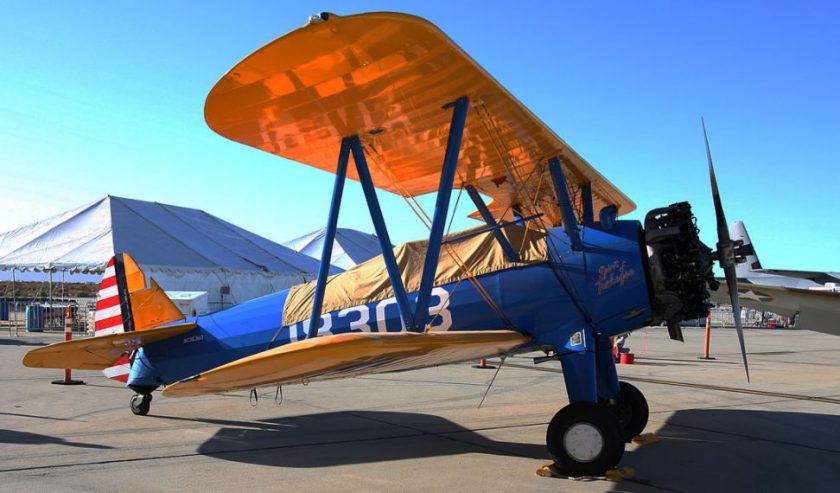
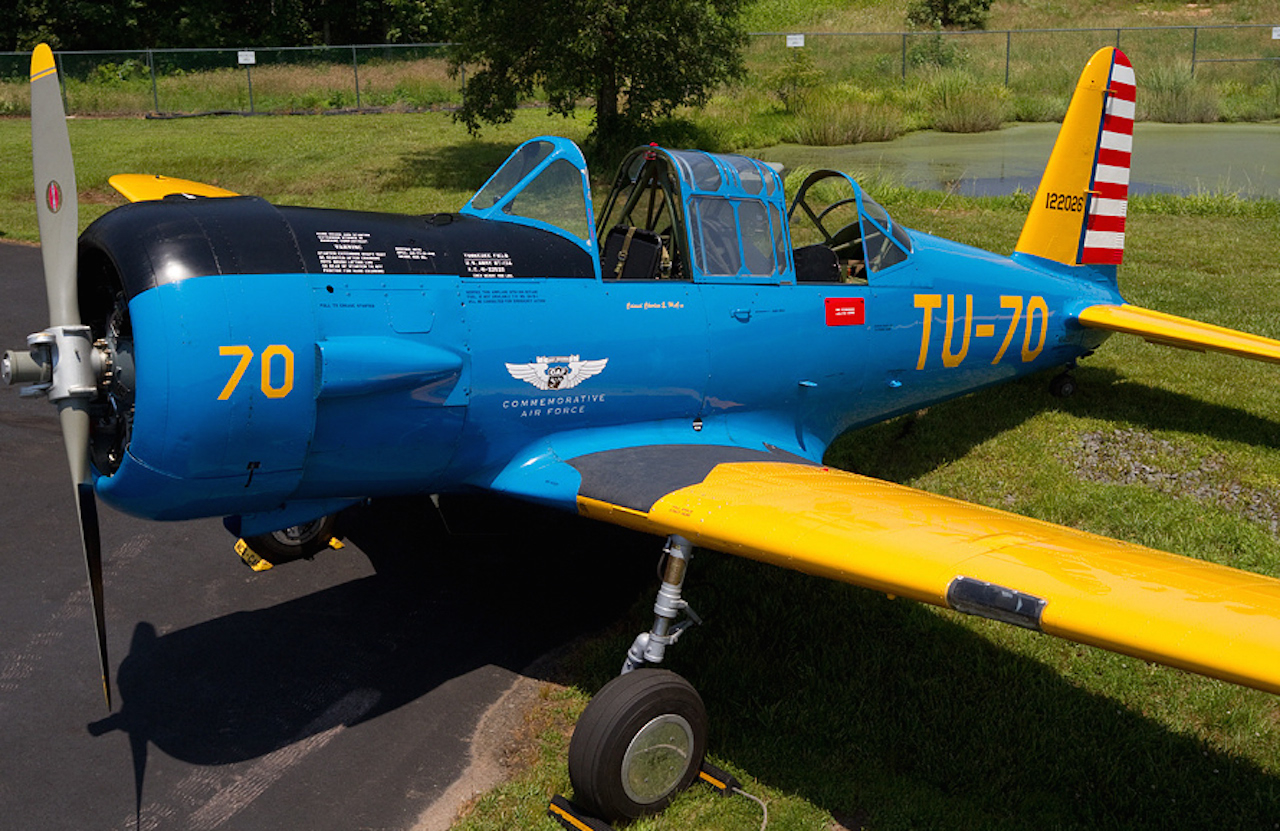
Surviving Tuskegee Airmen often refer to their instruction as what could “make or break a cadet.” After primary training, cadets moved on to basic and advanced flight training at Tuskegee Army Air Field, about seven miles from Moton Field. After primary training, cadets moved on to basic and advanced flight training at Tuskegee Army Air Field, about seven miles from Moton Field.
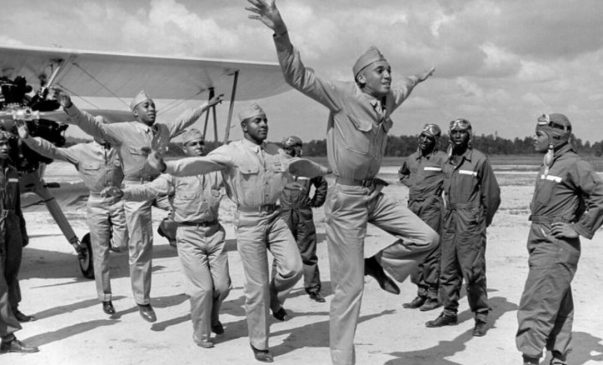
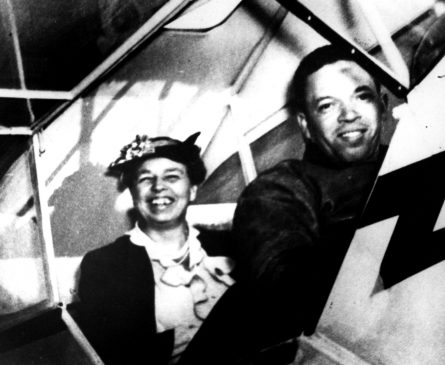
Terry would use Airport 1 and Kennedy Field, which was no more than a sod runway with a few buildings for aircraft and refueling equipment. It’s nice because that was exactly what Terry had used back in Basking Ridge. Kennedy became most known for Charles A. (“Chief”) Anderson’s famous flight with First Lady Eleanor Roosevelt in 1941.
Among the 13 members of the first class of the Tuskegee aviation cadets in 1941 was Benjamin O. Davis Jr., a graduate of West Point and the son of Brigadier General Benjamin O. Davis, one of two black officers (other than chaplains) in the entire U.S. military at the time.
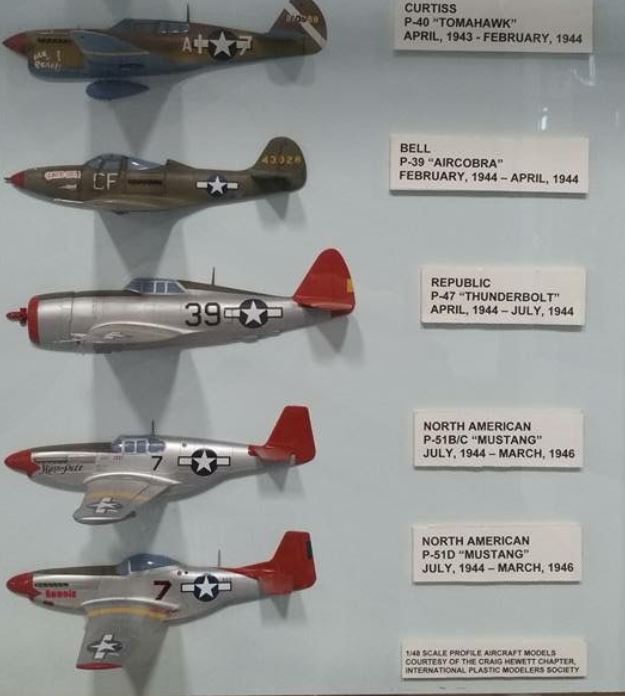
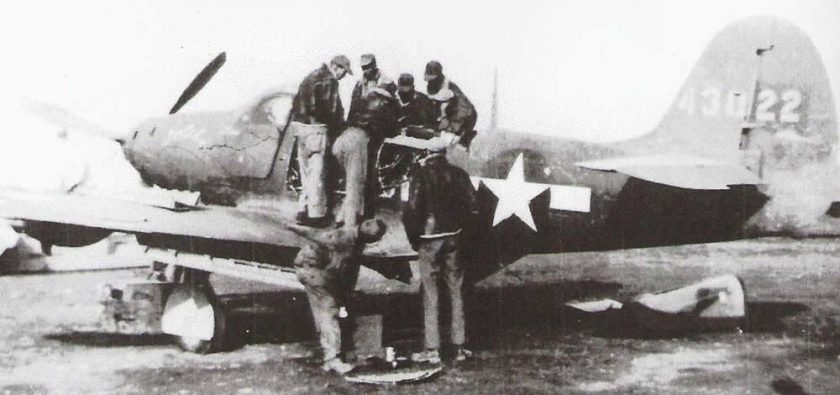
After The War
We fast forward to March 2007. President George W. Bush (45) presided over a ceremony in which he announced that Congress had authorized the awarding of a Congressional Gold Medal to honor the Tuskegee Airmen. Of the 300 attending, each received a bronze medal. The original gold is on display at the Smithsonian Institution in Washington, DC.
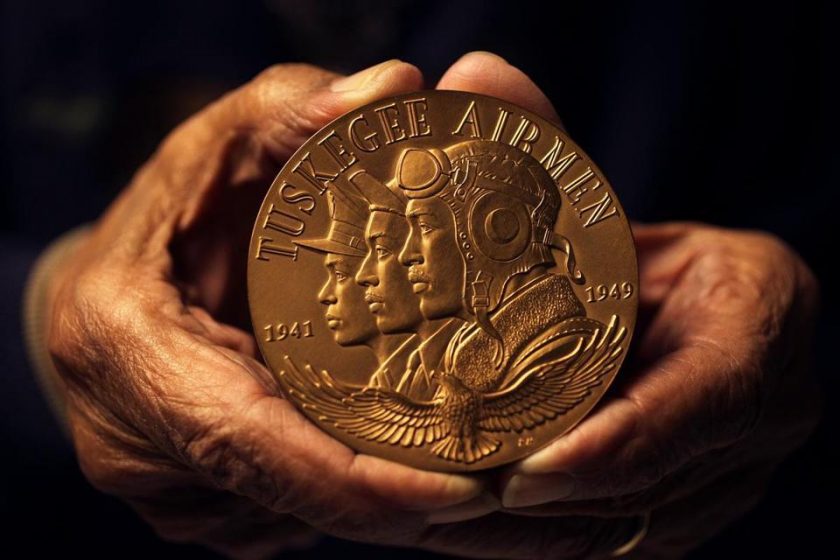
Robert Terry didn’t receive any decorations during his lifetime.
After the war, for Robert Terry, getting a pilot’s job was more important than medals. Terry submitted applications to every commercial airline but never got past the first interview when it became obvious he was black. With no other option, Terry was offered the “chief pilot and instructor” role at the Somerset Hills airfield. Terry also ran an air taxi service to LaGuardia and other large-area airports.
Terry’s story was similar to all the other Tuskegee Airmen instructors. Perry Young, a black co-worker and fellow instructor, had the same experience. They would send out applications to every commercial airline, but they never got past the first interview when it became obvious they were black. It took over a decade of fighting racism for Perry Young (Terry’s co-worker) to finally land a job with New York Airways. Flying a Sikorsky S-58, he was the first black pilot employed by a U.S. airline.
Other Notable Tuskegee Instructors
“The Chief” Tuskegee Instructor
Charles Alfred Anderson, Sr., from Bryn Mawr, Pennsylvania, was an American aviator who is known as the Father of Black Aviation. He earned the nickname “Chief” as the chief flight instructor of the Tuskegee Airmen.
In 1940, Anderson was recruited by the Tuskegee Institute in Alabama to serve as the Chief Civilian Flight Instructor for its new program to train black pilots. He developed a pilot training program, taught the Program’s first advanced course, and earned his nickname, “Chief”. In March 1941. By June 1941, Anderson was selected by the Army as Tuskegee’s Ground Commander and Chief Instructor for aviation cadets of the 99th Pursuit Squadron, America’s first all-black fighter squadron.
Tuskegee Airmen in The Movies
You have to admit, when George Lucas Films get involved, you know the movie is going to be big. Here are just two of the many stories that were filmed honoring the Tuskegee Airmen.
“We performed ably and well,” he said. “There’s so much human waste: waste of minds, waste of talent. As a result, we lose a lot of talent. We lose a lot of our greatness.”
Thomas Tindall, the Tuskegee lesson is that prejudice harms every part of society, not just those who are discriminated against.
Side Notes
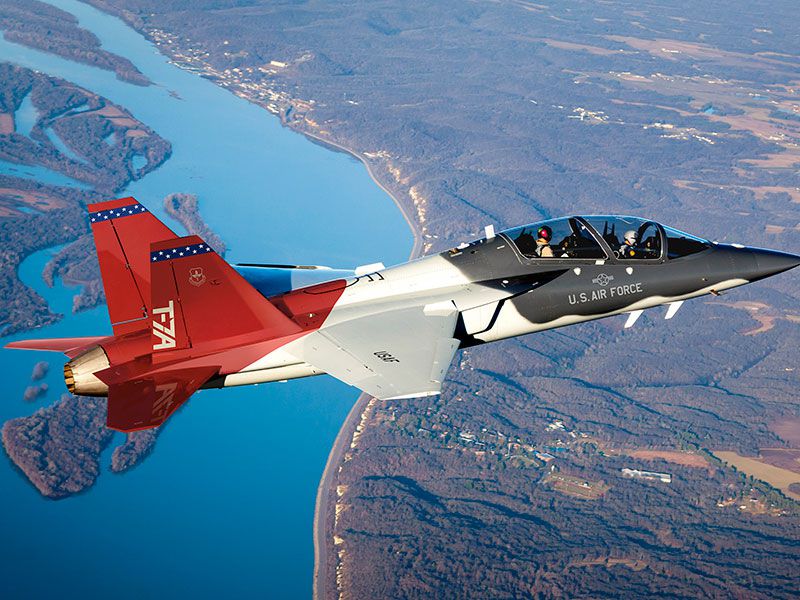
- North Carolina A&T University was one of the original Civilian Pilot Training Act black colleges where Robert Terry got his chance.
Students learned on Oct. 1, 1940, that A&T would offer flight training in conjunction with the ground school courses that were already offered at the school. The school was one of six black schools selected for the Civilian Pilot Training Program. A&T, Tuskegee, Delaware State University, West Virginia State University, Howard University, and Hampton University were the black schools selected to participate in the program. - The Tuskegee Airmen flew hundreds of patrol and attack missions for the Twelfth Air Force, flying P-40 and P-39 airplanes, before they were reassigned to the 15th Air Force to escort B-17 and B-24 heavy bombers, using P-47 and P-51 airplanes.Combat aircraft of the Tuskegee Airmen.
- Of the graduates, 352 pilots deployed overseas (Europe) for combat duty.
- In late March 1941, Eleanor Roosevelt, the wife of President Franklin D. Roosevelt, visited Tuskegee and flew with C. Alfred Chief Anderson, a pioneer black aviator and respected instructor at Tuskegee Institute.
- Some of the white officers at Tuskegee Army Air Field were very supportive of the Black military flight training. Others in higher places were not eager to see the Black military pilots serve in combat overseas after they were trained and resisted their deployment.
- There were 992 Tuskegee Airmen pilots trained at Tuskegee, including single-engine fighter pilots, twin-engine bomber pilots, and liaison and service pilots, but the total number of Tuskegee Airmen, counting ground personnel such as aircraft mechanics and logistical personnel, was more than 14,000.
- For every Black pilot, there were 12 other Black men and women performing ground support duties.
- The Tuskegee Airmen pilots are best remembered for flying fighters in the Mediterranean theater, first for the Twelfth Air Force, under which they flew hundreds of missions, and later for the Fifteenth Air Force.
- German pilots, who both feared and respected the Tuskegee Airmen, called them the “Schwartze Vogelmenschen” (or “Black Birdmen”). White American bomber crews reverently referred to them as the “Black Redtail Angels” because of the bright red paint on the tail assemblies of their fighter aircraft and their reputation for not losing bombers to enemy fighters as they provided close escort for bombing missions over strategic targets in Europe.
- 66 of these pilots were killed in combat, while another 32 were either forced down or shot down and captured to become prisoners of war. These Black airmen came home with 150 Distinguished Flying Crosses, Bronze Stars, Silver Stars, and Legions of Merit, one Presidential Unit Citation, and the Red Star of Yugoslavia.
- In late March 1941, Eleanor Roosevelt, the President’s wife, visited Tuskegee and flew with a Black pilot at the Tuskegee Institute’s civilian pilot training facility.
- Some of the white officers at Tuskegee Army Air Field were very supportive of the Black military flight training. Others in higher places were not eager to see the Black military pilots serve in combat overseas after they were trained and resisted their deployment.
- https://www.nationalww2museum.org/war/articles/tuskegee-airmen-interview-daniel-haulman
- Take a look at Training the Best; Charles Herbert Flowers, Jr. Tuskegee Airman Flight Instructor By Dorothy M. Poole · 2009.
- WW2 National War Museum interview with Tuskegee Airmen Daniel Haulman
- Tuskegee AAF closed August 20, 1946.
- In September 1947, the United States Air Force, as a separate service, reactivated the 332d Fighter Group under the Tactical Air Command. Members of the 332d Fighter Group were `Top Guns” in the 1st annual Air Force Gunnery Meet in 1949.
Tuskegee Pilots from New Jersey
929 pilots (American) are listed as graduates of the Tuskegee Institute and the Tuskegee Experiment. Of that number, 46 were from New Jersey, with Essex County and Jersey City leading the way.
Following each name is their class number, graduation date, rank held at Tuskegee, serial number, and hometown. This list DOES NOT include the names of all individuals who PARTICIPATED IN the Tuskegee Airmen pilot training program or support operations. Individuals who have documented proof that they participated in the Tuskegee Airmen experience are also called “Documented Original Tuskegee Airmen (DOTA).”
| Pilot |
| Alexander, Walter G. 45-D-SE 6/27/1945 2nd Lt. 0842999 Orange NJ |
| Ashby, Robert 45-H-TE 11/20/1945 2nd Lt. 0843351 Jersey City NJ |
| Bell, John J. 44-I-SE 11/20/1944 Flt. Officer T67141 Jersey City NJ |
| Black, Samuel A. 43-K-TE 12/5/1943 2nd Lt. 0817595 Plainfield NJ |
| Bynum, Rolin A. 44-A-TE 1/7/1944 2nd Lt. 0819447 Montclair NJ |
| Carpenter, Russell W. 44-I-SE 11/20/1944 2nd Lt. 0839085 Plainfield NJ |
| Chambers, Charles W. 46-A-SE 3/23/1946 2nd Lt. 02102097 Camden NJ |
| Clayton, Melvin A. 45-A-TE 3/11/1945 2nd Lt. 0841268 Salem NJ |
| Connell, Victor L. 45-D-SE 6/27/1945 2nd Lt. 0843003 Nutley NJ |
| Dabney, Roscoe J., Jr. 45-F-TE 9/8/1945 2nd Lt. 0843244 Lakewood NJ |
| Driver, Elwood T. 42-I-SE 10/9/1942 2nd Lt. 0792781 Trenton NJ |
| Dunne, Charles A. 43-H-SE 8/30/1943 2nd Lt. 0811277 Atlantic City NJ |
| Exum, Herven P. 44-I-1-TE 10/16/1944 Flt. Officer T66409 Wilson NJ |
| Gaiter, Roger Bertram 44-B-SE 2/8/1944 2nd Lt. 0821910 Seaside Hgts. NJ |
| Glenn, Joshua 44-K-SE 2/1/1945 Flt. Officer T68703 Newark NJ |
| Govan, Claude B. 43-B-SE 2/16/1943 2nd Lt. 0797219 Newark NJ |
| Griffin, Frank 45-I-SE 1/29/1946 Flt. Officer T149962 Asbury Park NJ |
| Harris, Archie H., Jr. 44-K-TE 2/1/1945 2nd Lt. 0841163 Ocean City NJ |
| Hawkins, Thomas L. 44-E-SE 5/23/1944 Flt. Officer T63113 Glen Rock NJ |
| Henry, Warren E. 44-H-TE 9/8/1944 2nd Lt. 0838037 Plainfield NJ |
| Jenkins, Edward M. 45-A-SE 3/11/1945 2nd Lt. 0841267 Nutley NJ |
| Johnson, Clarence 45-D-SE 6/27/1945 2nd Lt. 0843006 Newark NJ |
| Lawrence, Robert W. 44-F-SE 6/27/1944 2nd Lt. 01640660 Bloomfield NJ |
| Mason, Vincent 43-J-SE 11/3/1943 2nd Lt. 0814820 Orange NJ |
| Miller, Charles E. 44-I-1-SE 10/16/1944 2nd Lt. 0838156 Plainfield NJ |
| Pennington, Robert F. 45-B-SE 4/15/1945 Flt. Officer T69745 Little Silver NJ |
| Rice, Clayo C. 45-A-SE 3/11/1945 2nd Lt. 0841260 Bridgetown NJ |
| Rice, Price D. 42-I-SE 10/9/1942 2nd Lt. 0792786 Montclair NJ |
| Rich, Daniel L. 44-D-SE 4/15/1944 2nd Lt. 0828057 Rutherford NJ |
| Richardson, Eugene J., Jr. 45-A-SE 3/11/1945 2nd Lt. 0841261 Camden NJ |
| Robinson, Spencer M. 45-A-SE 3/11/1945 2nd Lt. 0841262 Monroe NJ |
| Rodgers, Marion R. 44-B-SE 2/8/1944 2nd Lt. 0821920 Elizabeth NJ |
| Scott, Floyd R., Jr. 45-F-SE 9/8/1945 Flt. Officer T70423 Asbury Park NJ |
| Scott, Henry B. 43-I-SE 10/1/1943 2nd Lt. 0814206 Jersey City NJ |
| Shults, Lloyd R. 44-D-TE 4/15/1944 2nd Lt. 0828044 N. Plainfield NJ |
| Smith, Albert H. 45-A-SE 3/11/1945 Flt. Officer T68758 Jersey City NJ |
| Spann, Calvin J. 44-G-SE 8/4/1944 Flt. Officer T64642 Rutherford NJ |
| Street, Thomas C. 44-G-SE 8/4/1944 2nd Lt. 0835415 Springfield NJ |
| Talton, James E. 45-F-TE 9/8/1945 Flt. Officer T136691 Merchantville NJ |
| Walker, William C., Jr. 44-E-SE 5/23/1944 2nd Lt. 0830795 Atlantic City NJ |
| Wanamaker, Geo, rge , , E. 45-C-S, E 5/23/1945 Flt. Officer T69980 Montclair NJ |
| Washington, Morris J. 44-I-TE 11/20/1944 Flt. Officer T67157 Atlantic City NJ |
| Watson, Spann 42-F-SE 7/3/1942 2nd Lt. 0790467 Hackensack NJ |
| Wilkerson, William G. 43-F-SE 6/30/1943 2nd Lt. 0807113 Camden NJ |
| Willette, Leonard R. 44-B-SE 2/8/1944 Flt. Officer T62308 Belleville NJ |
| Williams, Raymond L. 45-D-SE 6/27/1945 Flt. Officer T70109 Jersey City NJ |
929 – American pilot graduates
5 – Haitian pilot graduates
11 – Instructor pilot graduates
51 – Liaison pilot graduates
Total pilot graduates: 996 (686 SE graduates and 248 TE graduates
American and Haitian only).
[SE = Single Engine (fighter) and TE = Twin Engine (bomber)]
There were 44 classes that graduated during the “Tuskegee
Experience.”
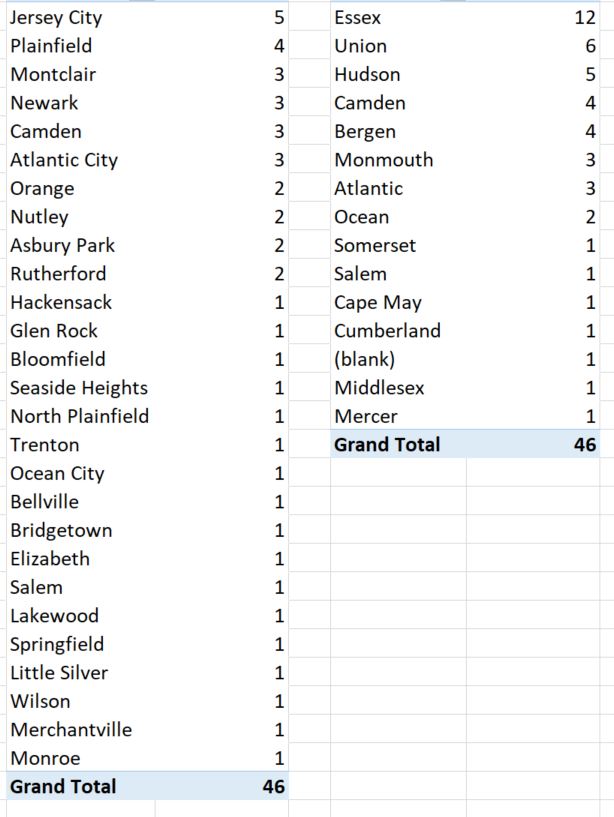
Original Post: August 10, 2020
Updated: August 2021
Updated: July 2023




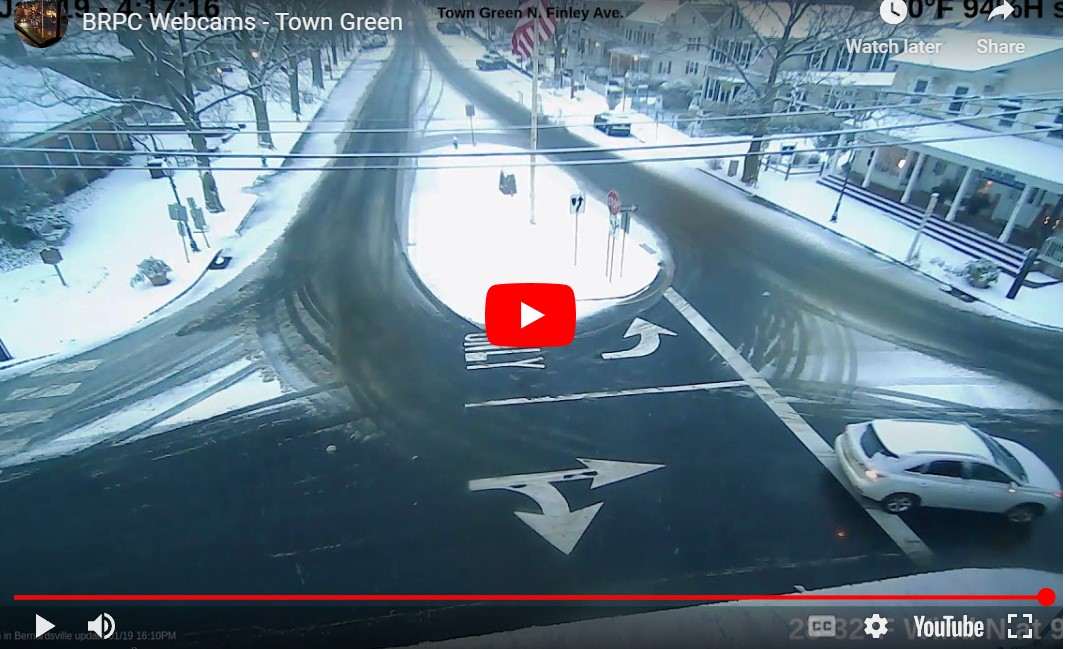

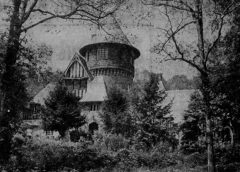




Excellent work on all the information. Really well done.
This was an excellent read! So grateful to learn about Mr. Terry.